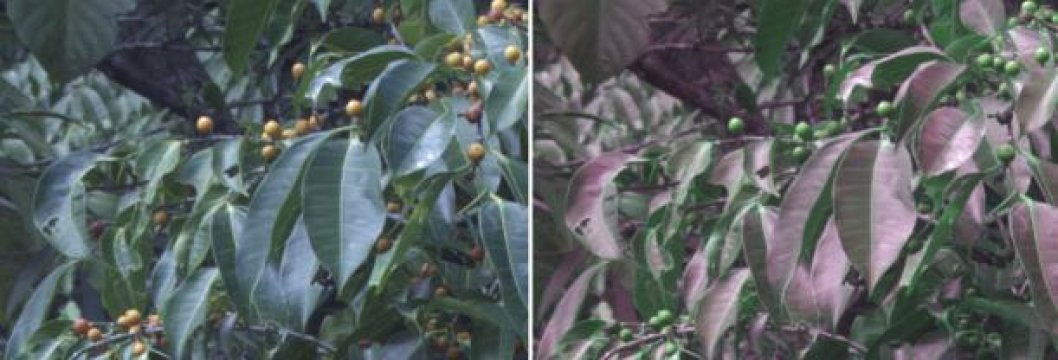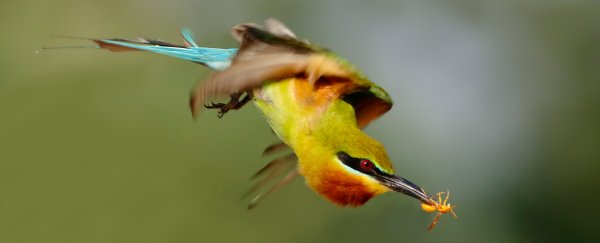Birds see a very different world to the one we're familiar with, and now we can get a hint of what that looks like thanks to a specially designed camera that simulates birdo-vision.
Apart from being fascinating, the resulting images also explain why birds can navigate so accurately through dense foliage.
Behavioural biologist Cynthia Tedore formerly from Lund University in Sweden explains that the team wanted to look for patterns in nature that birds see, but scientists have not yet thought to look for.
They chose to explore bird vision because birds are very visually orientated - they use their sight to forage and hunt for food - and unlike human eyes, bird eyes can detect a fourth colour.
In our eyes, we have three types of colour receptors, or cones - they are sensitive to red, blue and green frequencies of light. Birds have a fourth receptor that varies across species in the type of frequency it can detect.
Some birds, like Australian honeyeaters, have their fourth colour receptors sensitive to violet light; in others, such as parrots, these cones can detect light further into the UV part of the spectrum.
To find out how these violet- and UV-sensitive cones translate visually, researchers photographed dense forest habitat in both Sweden and Australia using a multispectral camera with specially designed filters to mimic what a bird can see.
What they discovered was quite striking.
 Normal photo, left. Photo that includes green light and UV colours, right. (Cynthia Tedore)
Normal photo, left. Photo that includes green light and UV colours, right. (Cynthia Tedore)
The multispectral images clearly show how UV sensitivity detects a greater contrast between the upper and lower surfaces of leaves, making each leaf's position and orientation stand out in a very clear, 3D way.
"What appears to be a green mess to humans are clearly distinguishable leaves for birds. No one knew about this until this study," said biologist Dan-Eric Nilsson, also from Lund University.
Both the upper and lower leaf surfaces reflect similar levels of UV light, so the researchers think the differences are due to how much UV the leaves reflect versus transmit.
UV light was reflected off the leaves more than 25 times the amount that was transmitted through them.
In comparison, our beady eyes can't tell the difference because green light is both transmitted and reflected around the same amount, creating far less contrast when viewed through green frequencies.
"[UV vision] likely helps birds fly and hop through dense foliage with greater agility," Tedore told ScienceAlert.
"Many birds search for insects and spiders hiding on the lower surfaces of leaves, and being able to quickly pinpoint these surfaces should enhance their foraging efficiency."
Using computer modelling, Nilsson and Tedore also worked out that the maximum leaf contrast is seen at short UV wavelengths in well-lit, open canopies and at longer UV wavelengths in lower-lit, closed canopies. This may explain why the fourth colour birds detect varies.
Of course, what we see in the visualised UV images is only a simulation of bird vision because our eyes are sadly not fully up to the task.
"Since birds have four cone classes (red, green, blue, and UV), and we only have three (red, green, blue), we can only visualise three of birds' cone channels at a time," Tedore explains. "It is impossible for us to generate a realistic representation of what vision with four cone channels might look like."
But even if we can't truly see these extra colours ourselves, we could still make use of bird super-colour-vision through technology.
"The enhanced 3D structure in the UV could be visualised by remotely-controlled or autonomous vehicles to help them better navigate complex forest environments without becoming entangled by leaves," Tedore suggests.
As amazing as seeing in four colours sounds, it probably also comes with some drawbacks.
"One disadvantage of having a fourth cone class is that it takes up space in the retina that could have been occupied by more of the other three cone classes," says Tedore. "This can have detrimental effects on resolution and on sensitivity under dim light conditions."
Tedore says the next step in understanding bird vision will be to see how their food sources display in UV. And they could also further explore how bird vision varies across species and environments.
"We may have the notion that what we see is the reality, but it's a highly human reality. Other animals live in other realities, and we can now see through their eyes and reveal many secrets. Reality is in the eye of the beholder," Nilsson concludes.
Their paper was published in Nature Communications.
